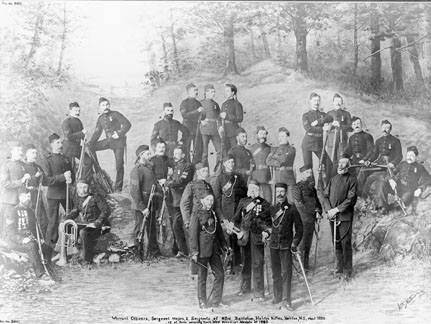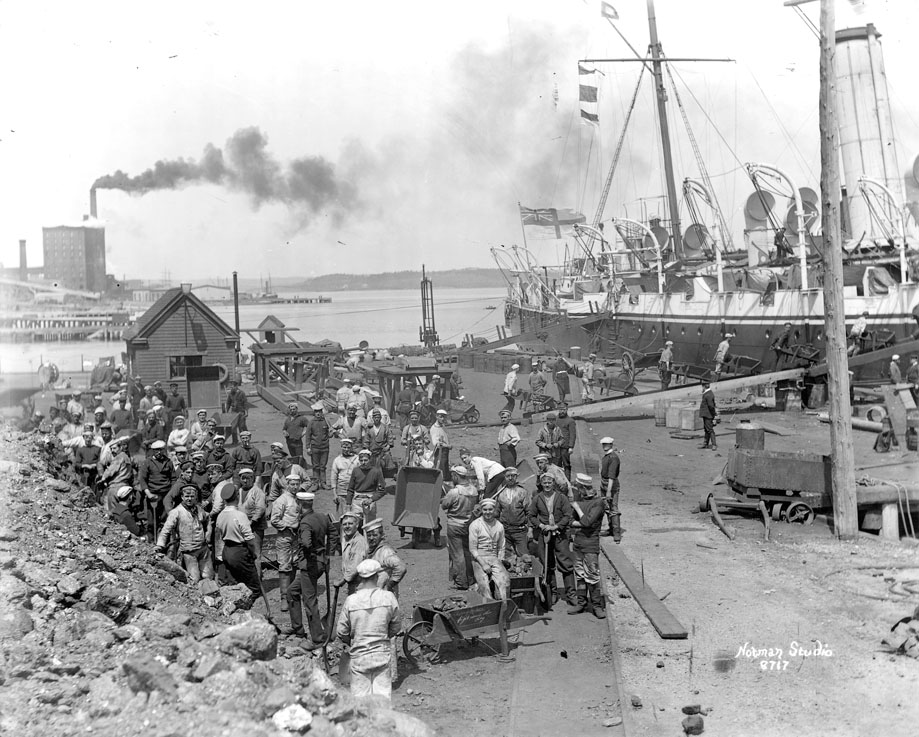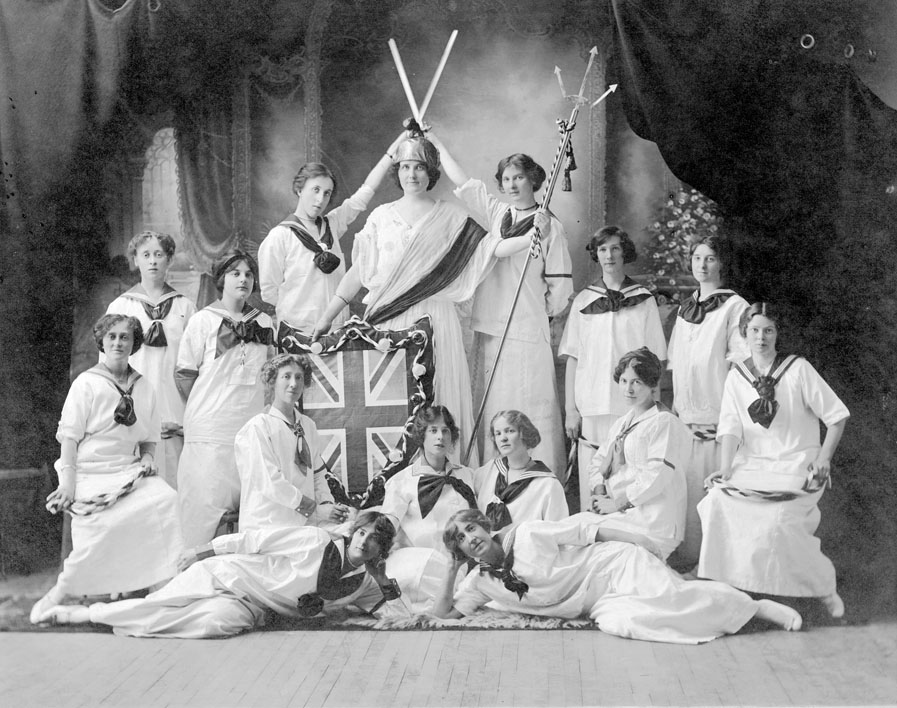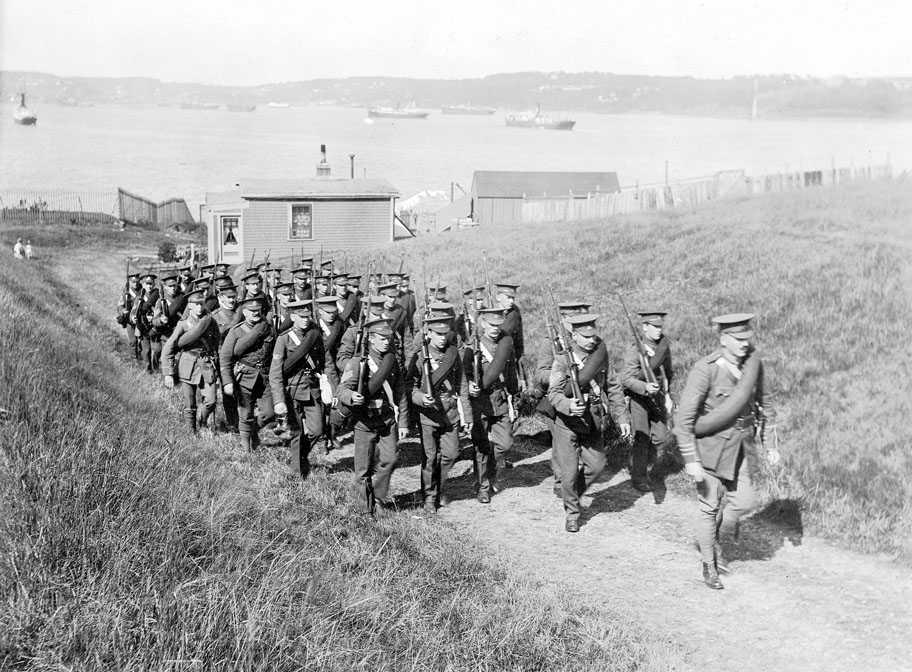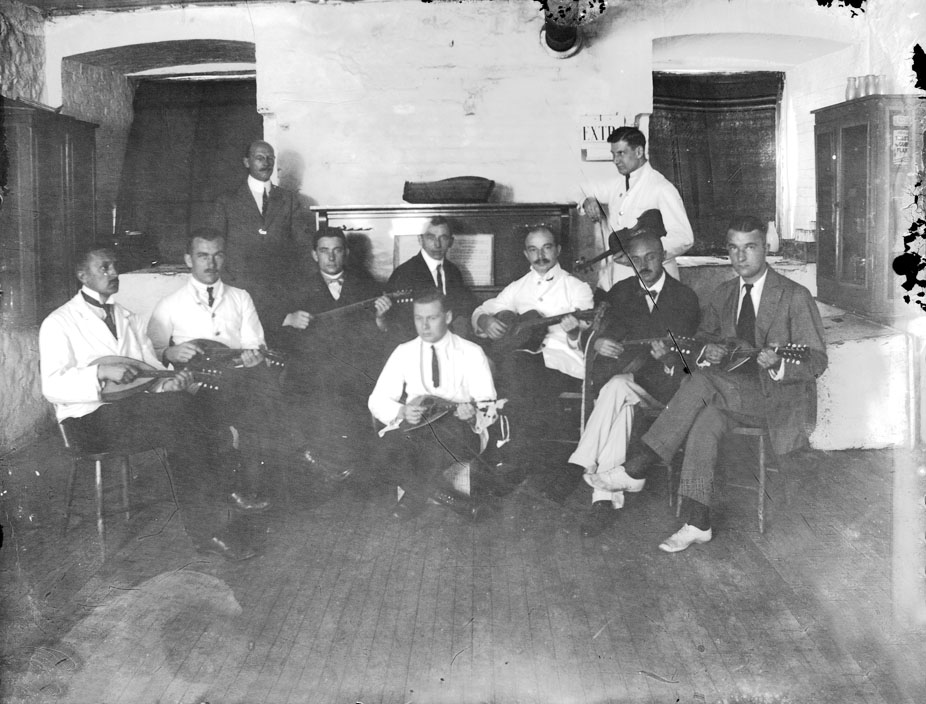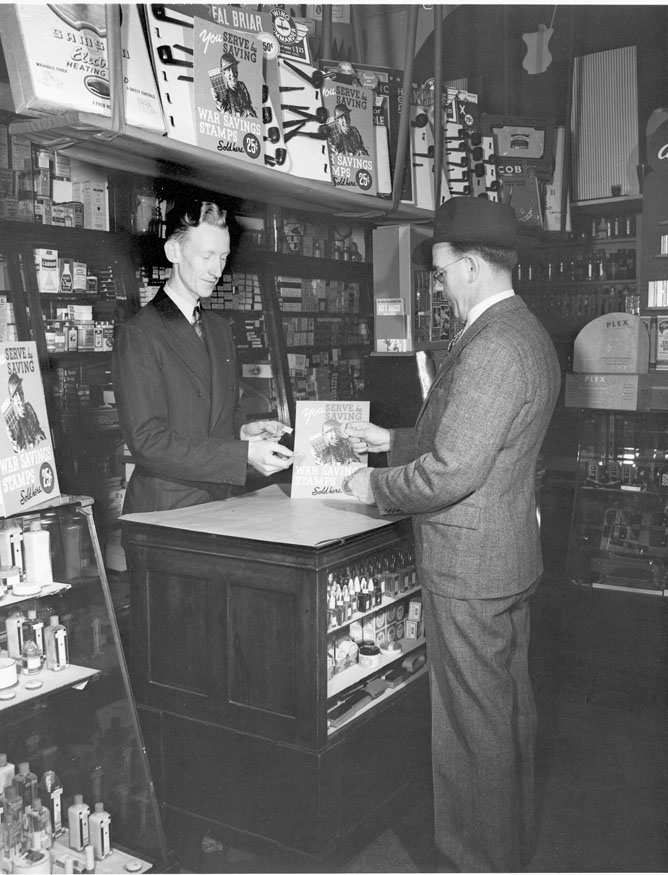Nova Scotia Archives
Halifax and Its People / 1749-1999
Halifax at War
Halifax has always been a Garrison City and continues so to this day, with much of the local economy still dependent upon the military presence. In earlier times, fortunes rose and fell on a tide of circumstances usually unfolding far away. For example, massive expeditions launched against the French military garrisons and naval bases at Louisbourg (1758) and Québec (1759) were organized in and sailed from Halifax Harbour — and indeed, the community had been founded in 1749 to offset the growing French presence in eastern North America.
During the War of the American Revolution, the Napoleonic Wars and the War of 1812, privateers routinely sailed in and out of Halifax Harbour, fortunes were made on their booty, and both French and American prisoners-of-war were held on Melville Island and elsewhere in the city. For most of the nineteenth century, however, Halifax's strategic importance within the British Empire languished; although naval vessels and military regiments came and went, the Garrison City was essentially an outpost and an imperial backwater. Nevertheless, the British remained until the turn of this century, leaving only in 1905-06 when they transferred the Halifax Defence Complex (the Citadel, York Redoubt and the various harbour defence stations) to the new Canadian Army; and shortly afterwards, the Dockyard facilities to the Canadian Navy. Many Haligonians, however, can still remember the old Pavilion or North Barracks which survived at the bottom of Citadel Hill until the late 1950s, a tangible reminder to all of the British Garrison in its heyday.
During World War I, Halifax was again an important naval base: this time the Royal Canadian Navy, in its infancy, patrolled the coast, and the port was a strategic trans-shipment point for troops mobilized for 'Overseas Active Service' in war-ravaged Europe. On 6 December 1917, the Norwegian vessel SS Imo, carrying Belgian Relief supplies, and the French freighter SS Mont Blanc, carrying a lethal load of munitions, collided in Halifax Harbour. The explosion which resulted was the largest man-made one before the atomic bomb in 1945, and triggered both death and destruction on a massive scale throughout Halifax and Dartmouth. The memory of that day has never been erased from either our physical landscape or from our collective identity as a community.
Halifax again became a centre of wartime activity after Canada declared war on Nazi Germany in 1939. Once more the port became a strategic mobilization and trans-shipment point. Throughout World War II, a total of 17,593 vessels passed through the port, safely brought in through the submarine nets deployed across the harbour mouth, then temporarily moored in Bedford Basin where they were formed into huge convoys to transport troops and supplies across the Atlantic. Meanwhile, Halifax Shipyards repaired some 7,000 vessels damaged in submarine warfare during the Battle of the Atlantic.
When the German surrender became official on V-E Day in May 1945, Halifax went wild — servicemen and civilians alike. Pent-up emotions, repressed through six years of rationing, overcrowding, the constant threat of attack, and quiet friction between the transient military and settled populations, boiled over all at once. Naval personnel stormed a streetcar, cleared out the driver and passengers, then set the vehicle ablaze.
Thomas H. Raddall, remembering the day in Halifax: Warden of the North, wrote that "Bacchanalia followed. Two shops were set afire, and all along the downtown streets sailors, waterfront toughs, and women of all sorts from giddy young girls to wizened hags could be seen smashing bottlenecks on the curbs, drinking themselves senseless, and lolling among the strewn merchandise on the sidewalks and in the gutter." Raddall also recorded that photographers took pictures of the riot and he commented that "One filthy harridan, staggering along Barrington Street at the height of the riot with her arms full of stolen finery, shrieked again and again, 'Never had so much fun in my life!' "
Two months later, memories of the 1917 Explosion were rekindled when an ammunition barge blew up at the Naval Magazine in Bedford Basin. The city mobilized for evacuation, but fortunately only a series of small localized explosions occurred and the dreaded 'big blast' never happened.
Results 1 to 12 of 12 from your search: Halifax at War
"Warrant Officers, Sergeant Majors & Sergeants of 63rd Battalion, Halifax Rifles, Halifax, N.S., about 1890. 13 of them wearing North-West Rebellion Medals of 1885"
Date: ca. 1890
Photographer: Notman Studio
Reference: Notman Studio Nova Scotia Archives no. 100059
Click for more information on this chapter.
Coaling HMS Charybdis at HM Dockyard, Halifax, [189-?]
Date: 1890s
Photographer: Notman Studio
Reference: Notman Studio Nova Scotia Archives no. 8717
Click for more information on this chapter.
Troop Transport Ship Idaho Disembarking Boer War Troops, Halifax, 1900
Date: 1900
Photographer: O. Bertram Stubbs
Reference: Nova Scotia Archives Photo Drawer - Army - Boer War
Click for more information on this chapter.
"Patriotic Concert for Belgian Relief Fund by Staff of Mahons Limited: Tableau Britannia", between 1914 and 1918
Date: between 1914 and 1918
Photographer: Climo
Reference: Joan Galloway Nova Scotia Archives 1989-222 no. 3
Click for more information on this chapter.
"Detachment No. 4 Co'y. 1st Regt. Canadian Garrison Artillery, Fort Charlotte, Halifax",1914
Date: 1914
Photographer: Climo
Reference: Schooner Books Nova Scotia Archives
Click for more information on this chapter.
Prisoners of War, Halifax Citadel, ca. 1917
Date: ca. 1917
Photographer: Notman Studio
Reference: Notman Studio Nova Scotia Archives no. 47
Click for more information on this chapter.
Maud Foley, Street Car Conductor in Summer Uniform and Winter Uniform, Halifax, 1917 or 1918
Date: 1917 or 1918
Reference: Nova Scotia Light and Power Co. Nova Scotia Archives MG 9 vol. 226, pp. 27-28
Click for more information on this chapter.
British Evacuee Children arriving in Halifax, 1941
Date: 1941
Photographer: E.A. Bollinger
Reference: E.A. Bollinger Nova Scotia Archives 1975-305 1941 no. 419-B
Click for more information on this chapter.
"Store with War Savings Stamps", 1942
Date: 1942
Photographer: E.A. Bollinger
Reference: E.A. Bollinger Nova Scotia Archives 1975-305 1942 no. 618-A
Click for more information on this chapter.
V-E Day Rioters Walking along Salter Street between Hollis and Barrington Streets, May 1945
Date: May 1945
Reference: David Hall Nova Scotia Archives 1981-412 no. 8
Click for more information on this chapter.
V-E Day Rioters on Hollis Street between Blowers and Bishop Streets, May 1945
Date: May 1945
Reference: David Hall Nova Scotia Archives 1981-412 no. 11
Click for more information on this chapter.
War Brides Arrive on the Liner SS Scythia, 26 March 1946
Date: 26 March 1946
Photographer: Canadian Army Photo
Reference: H.B. Jefferson Nova Scotia Archives 1992-304 no. 25
Click for more information on this chapter.
